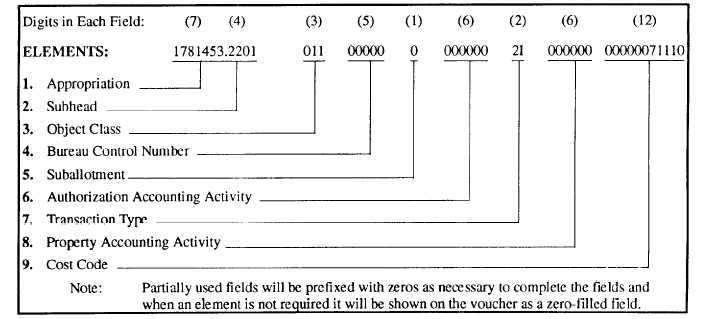| |
example of an accounting classification code that
contains the maximum number of elements is shown in
figure 2-2. Figure 2-2 also illustrates the order in which
the accounting data should be entered on the required
documents. You should follow the order shown in
figure 2-2, regardless of any preprinted instructions on
your document to the contrary. In the following
sections, we will explain the significance of each of
these elements and the order in which they should be
used.
We will also examine the position and
significance of the alphanumeric characters in each
element. While reading this information, remember to
refer to the example in figure 2-2. We will discuss these
elements and their characters in the order of their
numerical and sequential presentation in this figure.
APPROPRIATION OR FUND
In every accounting classification code, the first
element represents the appropriation or fund. (Refer to
number 1 on the left side of figure 2-2. This represents
the first element in the accounting classification code
used as the example.) The appropriation or fund, of
course, indicates the legal source of each transaction.
In most cases, the appropriation code will consist of
only seven alphanumeric characters. It may, however,
contain up to nine characters, depending on the
reporting requirements.
The first two digits in our example are 1 and 7, or
17, which represent the Department of the Navy. The
third digit, 8, is the last digit of the fiscal year for that
in the third position instead of a number, then the
appropriation is a continuing appropriation. If the letter
M is used in the third position, then the appropriation is
a successor appropriation.
The next four digits (1453) indicate the type of
appropriation. In the case of a fund, these four digits
would indicate the type of appropriation and the
particular type of fund used within that appropriation.
SUBHEAD
The second element of the accounting code
(indicated as number 2 on the left side of the figure) is
the subhead. This element identities the charges (or
credits) to the appropriation or fund (indicated in
element 1) for that particular transaction. The subhead
consists of four characters. The first two characters
identify the administering offices. The last two
characters identify the purpose of the subhead. For
example, the subhead 2201 in figure 2-2 identifies the
administering office, 22, as the Bureau of Naval
Personnel (BUPERS) and the purpose, 01, as pay and
allowances of officer personnel.
OBJECT CLASS
The object class is the third element in the
accounting classification code. (Refer to number 3 in
figure 2-2.) It consists of three digits. The object class
designates the nature of the services, articles, or other
items involved, as distinguished from the purpose for
particular annual appropriation. If the letter X is used
which obligations were incurred.
Figure 2-2.-The accounting classification code.
2-4
|

